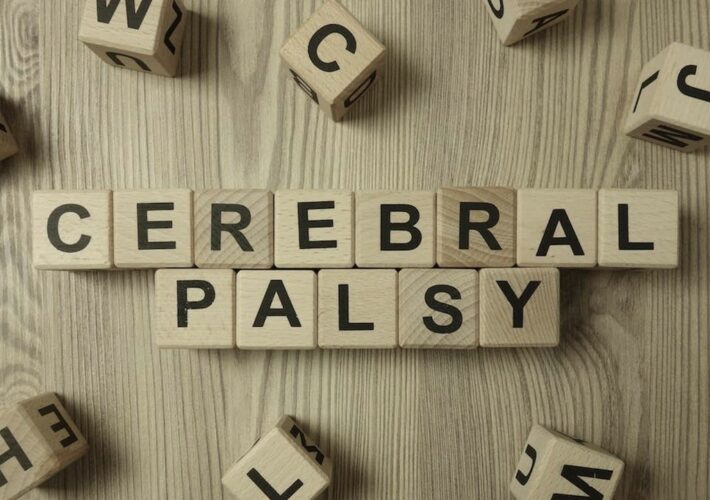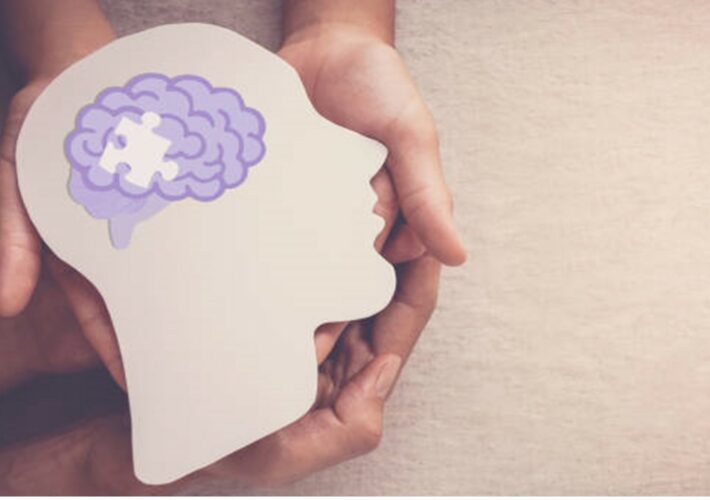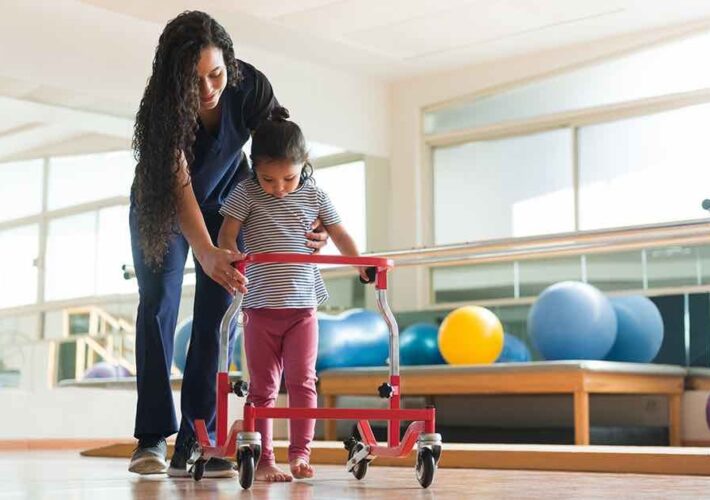My child has been diagnosed with cerebral palsy, GMFCS level II – what does that even mean? What functional limitations can I expect? Let’s not talk about limitations, but about capabilities. Gross Motor Function Classification System (GMFCS) categorizes different levels of a child’s functioning. The differences between the levels are based on the child’s functional abilities related to gross motor skills. This classification helps both – us, the healthcare professionals, and you, the parents, to know what to expect, to encourage your child’s full potential and to support him in the areas where he needs it. Find out more about each level’s characteristics in the article below!
TL;DR – the highlights:
- GMFCS – describes the abilities of children with cerebral palsy based on gross motor function
- a higher GMFCS level corresponds to greater functional deficits
- it helps us set more realistic goals in many aspects of care and provides information about the child’s future needs (e.g., assistive equipment, mobility aids)
- we expect GMFCS level classification to remain the same throughout an individual’s life
GMFCS – Gross Motor Function Classification System
Gross Motor Function Classification System (GMFCS) is a widely used classification tool that helps us categorize and describe the abilities of children and adolescents with cerebral palsy (CP). The GMFCS describes self-initiated movement and the use of aids (walkers, crutches, canes, wheelchairs) for mobility during the individual’s usual activity. The GMFCS has five levels to categorize a child’s functioning, lower levels correspond to milder forms of CP, while higher levels indicate greater severity. The differences between the levels are based on the child’s functional abilities related to gross motor skills. The focus of this classification system was to highlight a child’s abilities rather than limitations.
The importance of the GMFCS
The GMFCS is based on the child’s ability to self-initiate movement. It evaluates gross motor movements such as sitting, walking, and using mobility aids. It provides families and health care professionals with:
- a description of the child’s current motor function,
- an idea of assistive equipment or mobility aids that the child may need in the future (e.g., crutches, walking frames, wheelchairs).
Correct classification according to this system gives us a clear picture of their actual level of functioning rather than what they might be able to do occasionally. This is important for therapist, health care providers and even schools, as it can help determine therapy plans, lifestyle adjustments and rehabilitation potential for the future.

Classifying children with cerebral palsy into GMFCS level
The GMFCS classifies infants, children, and adolescents with CP into five groups based on three key factors:
- Gross motor function: Each child with CP is evaluated based on gross motor skills to determine the severity of the condition. Gross motor skills include activities such as standing, walking, running, catching, and throwing that require the use of larger muscle groups. These skills are often impaired because CP affects areas of the brain needed for balance, movement, and coordination, but the degree of impairment depends on the severity of the brain damage.
- Performance: In addition to gross motor skills, we assess how independent the child is in different environments such as home, school and community. If a child needs extensive assistance in any or all of these circumstances, this often indicates a more severe level of CP. We must keep in mind that this measurement evaluates the child’s performance under typical circumstances, not how he would behave under ideal conditions.
- Age: This classification also considers the individual’s age when assigning the GMFCS level, as different criteria are used for different age groups. There are five different age groups: 0 to 2 years, 2 to 4 years, 4 to 6 years, 6 to 12 years, and 12 to 18 years.1,2
For each individual child, these factors combine to provide a general idea of the severity of CP and help determine a plan for the future to support these children with their needs in the best possible way.
GMFCS levels – description for each level
There are five levels of GMFCS, increasing in severity from level I to level V. It is important to note that this classification system is intended as a general guideline and that every child is different, therefore, the GMFCS will not fully describe each. In general, the five levels are described as follows:
Level I: Walks without limitations
Functioning skills are quite good, although speed, balance, and coordination may be impaired. The child can move independently without help.

Level II: Walks with limitations
Child can walk with limitations and may need assistance on inclined or uneven surfaces, but there is no need for the assistance of adaptive equipment. Limitations may include balance or endurance, use of a hand-held mobility device before age 4, use of handrails on stairs, or inability to run or jump. In long term, functioning may result in the use of wheeled mobility to cover large distances.

Level III: Walks using a hand-held mobility device
Child can walk using hand-held adaptive equipment and may need a wheelchair to move on inclined or uneven surfaces, or to travel long distances.

Level IV: Self-mobility with limitations; may use powered mobility
Child is self-mobile, but with significant limitations. Many of them use electric wheelchairs, need a lot of help with transfers, and are dependent on adaptive and assistive equipment.

Level V: Transported in a manual wheelchair
All voluntary movements are usually impaired. Children classified in GMFCS V have more severe head and trunk control limitations. A child depends on adaptive equipment, assistive technology, and the help of other people to move. Self-mobility is only possible with an electric wheelchair.1,2

Age-specific characteristics of GMFCS levels – what you might expect as a parent
It’s all a bit overwhelming, I know. By now your child is most likely classified into one of the levels. So here are some differences for each level based on the child’s age, keeping in mind developmental milestones. These more detailed and age-appropriate descriptors allow for more accurate classification and give you a better idea of what to expect.
GMFSC level I
- 0 to 2 years: Babies learn to sit on the floor and hold objects with both hands without help. They can crawl on their hands and knees, pull themselves to stand up, cruise holding onto furniture, and are able to walk independently between 18 months and two years of age without assistance.
- 2 to 4 years: Skills include independent sitting and independent transition between sitting and standing.
- 4 to 6 years: The child can walk independently indoors and outdoors, climb stairs, and start to run and jump.
- 6 to 12 years: Additional abilities include walking on uneven surfaces, climbing stairs without railings, running, and jumping, but speed, balance, and coordination are limited to some extent. They can participate in physical activities and sports.1,2
- 12 to 18 years: Abilities are the same as for ages 6 to 12.2
GMFCS level II
- 0 to 2 years: A child under the age of two may need to use their hands to maintain balance while sitting upright on the floor. Some babies can move on all fours or crawl on their bellies. Some can even pull themselves up to the stand and take a few steps while holding on to the furniture.
- 2 to 4 years: They can now move in and out of a sitting position without assistance but may have problems with balance while manipulating objects with both hands. They move on all fours in a reciprocal pattern, cruise along the furniture, and walk with an assistive mobility device.
- 4 to 6 years: Children should be able to sit in a chair or on the floor and use their hands freely. They move into a stand but often need a stable surface to push or pull up. They can walk short distances and on flat surfaces without assistive devices. At this level, children can climb stairs by holding on to the railing but can’t run or jump.
- 6 to 12 years: Children can now walk indoors and outdoors with little or no assistance. For long distances, however, they still need help. Running and jumping remain minimal. They also need help carrying objects, climbing steps, and walking on uneven ground or inclined surface. They may need adjustments to participate in physical activities and sports.1,2
- 12 to 18 years: The abilities are the same as for ages 6 to 12, but a hand-held mobility device may be used for safety. They will probably need a wheelchair for longer distances.2
GMFCS level III
- 0 to 2 years: Infants need lower back support while sitting and assistance to sit up but can roll and crawl forward while on their bellies.
- 2 to 4 years: They can sit without support but sit in a “W” position with legs pointing back, knees bent and rotated inward. They crawl on their bellies and move on all fours, usually without reciprocal movement of their legs. They can pull themselves to a standing position with support on a stable surface and walk short distances indoors using a walker with some assistance for turning.
- 4 to 6 years: Children can sit in a chair but need trunk support to use their hands. While holding onto something firm, they can push themselves to a standing position and climb stairs with assistance. Independent walking also requires assistance, either from an adult or a mobility device. They often have difficulty traveling long distances or on uneven terrain.
- 6 to 12 years: Children can walk indoors and outdoors with the assistance of a hand-held mobility device. They can also climb stairs using a handrail under supervision or with the help of adults. However, they can’t walk long distances and need a wheelchair. Sit-to-stand and floor-to-stand transfers require physical assistance from a person or support surface. They need a seat belt for support them while sitting.1,2
- 12 to 18 years: Abilities are the same as for ages 6 to 12, but more variability is shown in primary mobility preferences. Walking is facilitated by a hand-held mobility device, but a powered or self-propelled wheelchair is usually used at school. Adaptations are necessary for participation in sports and other activities.2
GMFCS level IV
- 0 to 2 years: Babies can control their head and can roll back and forth on their own. Because they have no trunk control, they need help from adults to sit up.
- 2 to 4 years: Children can now sit up alone but need hands for support to maintain their position. Children may need adaptive equipment for sitting and standing. At this level, some self-mobility is possible by rolling or crawling to get around, but there is no reciprocal leg movement.
- 4 to 6 years: Children can walk short distances with a walker but under supervision at all times as they have problems with balance and coordination. With an electric wheelchair, they can achieve independent mobility. They also need trunk support while sitting.
- 6 to 12 years: Mobility in this age group generally remains the same, but once children start school, they tend to use mobility aids, such as wheelchairs, more often than at home. Children need an adaptive seating for trunk and pelvic control and physical assistance for most transfers.1,2
- 12 to 18 years: An electric wheelchair is required in most settings, along with an adaptive seat. Generally, one to two people will need to assist the transfer, although adolescents will be able to support their weight to assist with standing transfers. They need adaptations and physical assistance to participate in sports and other activities.2
GMFCS level V
- 0 to 2 years: Infants’ voluntary control of moving their limbs is limited. They need help in sitting up and rolling over, as well as trunk and head support while sitting.
- 2 to 4 years: Children continue to be minimally mobile or do not move independently at all. They need assistance in all areas of movement. Adaptive equipment can’t fully compensate for their limitations, although some children achieve self-mobility using an electric wheelchair with extensive adaptations.
- 4 to 18 years: There is no increase in function from the previous growth period. They continue to need assistance in all areas of mobility. Assistive technology is needed to improve head alignment, sitting, standing, and mobility but equipment doesn’t fully compensate for limitations. Transfers require complete physical assistance of an adult.1,2
Can a GMFCS level change over time?
We expect the GMFCS level classification to remain the same throughout an individual’s life, even with intervention, therapy, and rehabilitation. GMFCS levels provide parents and health care providers with information about each person’s rehabilitation potential and take into account any expected improvement in gross motor performance over time.3,4 However, even if this is the intended goal, it is not always the case. Sometimes a new GMFCS level can be assigned if unexpected improvement is achieved. However, current studies show that GMFCS levels are quite stable after two years of age.4,5,6
REFERENCES:
- Palisano R, Rosenbaum P, Walter S, Russell D, Wood E, Galuppi B. Development and reliability of a system to classify gross motor function in children with cerebral palsy. Dev Med Child Neurol. 1997 Apr;39(4):214-23. doi: 10.1111/j.1469-8749.1997.tb07414.x
- Palisano R, Rosenbaum P, Bartlett D, Livingston M. GMFCS – E & R. Gross motor function classification system expanded and revised. In CanChild Centre for Childhood Disability Research, McMaster University, Institute for Applied Health Sciences McMaster University: Hamilton, ON, Canada, 2007; p. b15.
- Rosenbaum PL, Palisano RJ, Bartlett DJ, Galuppi BE, Russell DJ. Development of the Gross Motor Function Classification System for cerebral palsy. Dev Med Child Neurol. 2008 Apr;50(4):249-53. doi: 10.1111/j.1469-8749.2008.02045.x
- Rosenbaum PL, Walter SD, Hanna SE, Palisano RJ, Russell DJ, Raina P, Wood E, Bartlett DJ, Galuppi BE. Prognosis for gross motor function in cerebral palsy: creation of motor development curves. JAMA. 2002 Sep 18;288(11):1357-63. doi: 10.1001/jama.288.11.1357
- Wood E, Rosenbaum P. The gross motor function classification system for cerebral palsy: a study of reliability and stability over time. Dev Med Child Neurol. 2000 May;42(5):292-6. doi: 10.1017/s0012162200000529
- Palisano RJ, Cameron D, Rosenbaum PL, Walter SD, Russell D. Stability of the gross motor function classification system. Dev Med Child Neurol. 2006 Jun;48(6):424-8. doi: 10.1017/S0012162206000934




